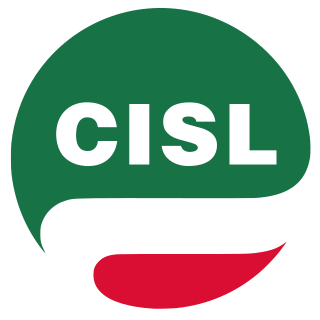
The Biennio Rosso was a two-year period, between 1919 and 1920, of intense social conflict in Italy, following the First World War. The revolutionary period was followed by the violent reaction of the fascist blackshirts militia and eventually by the March on Rome of Benito Mussolini in 1922.

Unione Sindacale Italiana was an Italian anarcho-syndicalist trade union. It was the Italian section of the International Workers' Association, and the name of USI was also abbreviated as USI-AIT.

Giuseppe Di Vittorio, also known as Mario Nicoletti, was an Italian trade union leader and communist politician. He was one of the most influential trade union leaders of the labour movement after World War I.

The Italian Confederation of Trades Unions is a national trade union centre in Italy representing various Catholic-inspired groups linked with Christian Democracy party.

The Italian General Confederation of Labour is a national trade union centre in Italy. It was formed by an agreement between socialists, communists, and Christian democrats in the "Pact of Rome" of June 1944. In 1950, socialists and Christian democrats split forming UIL and CISL, and since then the CGIL has been influenced by the Italian Communist Party (PCI) and until recent years by its political heirs: the Democratic Party of the Left (PDS), the Democrats of the Left (DS) and currently the Democratic Party (PD).

The Italian Labour Union is a national trade union centre in Italy. It was founded in 1950 as a socialist, social democratic, republican, and laic split from the Italian General Confederation of Labour (CGIL). It represents almost 2.2 million workers.
Italian anarchism as a movement began primarily from the influence of Mikhail Bakunin, Giuseppe Fanelli, and Errico Malatesta. Rooted in collectivist anarchism and social or socialist anarchism, it expanded to include illegalist individualist anarchism, mutualism, anarcho-syndicalism, and especially anarcho-communism. In fact, anarcho-communism first fully formed into its modern strain within the Italian section of the First International. Italian anarchism and Italian anarchists participated in the biennio rosso and survived Italian Fascism, with Italian anarchists significantly contributing to the Italian Resistance Movement. Platformism and insurrectionary anarchism were particularly common in Italian anarchism and continue to influence the movement today. The synthesist Italian Anarchist Federation appeared after the war, and autonomismo and operaismo especially influenced Italian anarchism in the second half of the 20th century.

The Workers Autonomous Trade Unions Confederation is an Italian autonomous trade union association.

General Confederation of Labour was an Italian labor union, founded in 1906, under the initiative of socialist militants. Having survived the Fascist dictatorship and the Second World War as an underground organization, the CGL joined the cross-party CGIL labor federation in 1945.

Vittorio Foa was an Italian politician, trade unionist, journalist, and writer.

Luca Visentini is an Italian trade unionist. Elected general secretary of the International Trade Union Confederation (ITUC) at the organisation's 5th World Congress in Melbourne, Australia, in mid-November 2022, he stood aside on 14 December 2022 following his arrest and conditional release in relation to the Qatar corruption scandal at the European Parliament. On 11 March 2023, the ITUC General Council voted to dismiss Visentini for accepting funds from Antonio Panzeri.
The National Federation of Local Authority and Healthcare Workers was a trade union representing public sector workers in Italy.
The Italian Federation of Textile and Clothing Workers was a trade union representing garment and textile workers in Italy.
The Italian Federation of Textile Workers was a trade union representing workers in the textile industry in Italy.
The Italian Union of Local Authority Workers is a trade union representing health and local authority workers in Italy.
The Union of San Marino Workers is a general union in San Marino.










